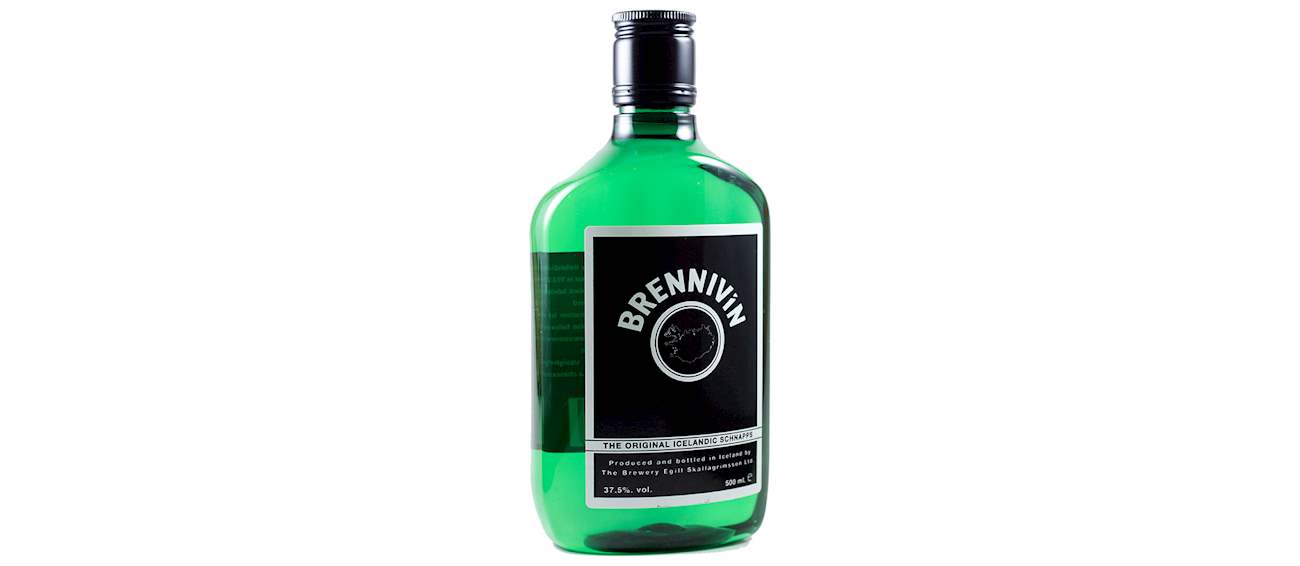MAIN INGREDIENTS
Karsk is an aromatic Norwegian cocktail that is traditionally served hot. It is made with a combination of coffee and moonshine. To prepare it, a small coin is traditionally placed on the bottom of the cup, which is then filled with strong, hot coffee until the coin is completely covered.
The moonshine is then added to the cup until the coin resurfaces. There is also a variation on Karsk made with vodka instead of moonshine. The name of this cocktail is derived from the adjective karsks, which means vigorous in Old Norse.
Brennivín is distilled from potato mash, and it is traditionally flavored with various herbs and spices, including caraway seeds, cumin, and angelica. Although the name Brennivín translates to burning wine, this strong spirit was nicknamed Svarti Dauði, meaning Black Death, presumably because the bottle once had a label depicting a black skull, while some claim the nickname originated due to the distinctive, sharp taste of the drink.
This Icelandic staple is best enjoyed well-chilled, served in a shot glass and paired with hákarl - cured shark flesh.
Koskenkorva is a clear Finnish spirit that is distilled from a combination of locally grown barley and unfiltered spring water. Often dubbed as vodka, the drink is produced with continuous distillation, which involves highly developed producing techniques that utilize 100% of the grain—none of it goes to waste.
The original version of this high-quality spirit is smooth, pure, neutral, and bright. Apart from its basic version, it also comes in several specialty varieties, including aged and flavored spirits. The drink is produced in Koskenkorva village, and the company which produces it operates in an entirely sustainable manner that focuses on the circular economy.
Akvavit is a Scandinavian spirit that is usually distilled from grains or potatoes. After distillation, it is infused with various botanicals, though the most common are caraway and dill. Other options may include fennel, coriander, cloves, or cumin.
The drink can vary in color, and its flavor profile can greatly differ depending on the age and the base ingredients. Danish and Swedish akvavit is typically clear and colorless, while the Norwegian version is sometimes aged in sherry casks, allowing it to attain golden-like color and slightly stronger flavor.
Jaloviina is a type of Finnish cut brandy, a type of brandy that has been cut with neutral grain spirit. This Finnish version is based on French brandy and the Finnish spirit. Jaloviina comes in several grades, usually differentiated by the number of stars.
One being the lowest, and three being the highest grade. Jaloviina is typically amber-colored and has a smooth flavor with a long, warming finish. The dink was introduced in 1932, following the end of prohibition in Finland. Jaloviina can be served neat or on the rocks, but it could also work well in mixed drinks.
Sahti is a traditional beer that is produced in the regions of Kanta-Häme, Päijat-Häme, and Pohjois-Satakunta. The beer is made with malted barley, other cereal malts, and cereals such as rye, barley, wheat, and oats. Apart from hops, this beer is sometimes fermented with the addition of juniper, and the wort can be filtered using juniper twigs and rye straws.
Sahti is made with local raw materials, following traditional methods and recipes, and without any additives. The beer is not pasteurized nor filtered. It can range from yellow to dark brown, and it has a slightly cloudy appearance, while its alcohol content may range from 6 % to 12 % ABV.
Norwegian farmhouse ale is an example of a traditional farmhouse ale—a versatile style brewed by European farmers. These beers were designed for local consumption. In Norway, they are known as maltøl, which would literally translate as malt beer.
Norwegian brewing tradition is ancient, and though it has changed over time, it retained some of its unique characteristics. The entire category of farmhouse ales is incredibly versatile. The character depends on the region, brewer’s preferences, and style.
VARIATIONS OF Maltøl
MAIN INGREDIENTS
Sima is a fermented Finnish drink, often classified as a low alcoholic variety of mead. It is a fizzy drink with a sweet and citrusy flavor that comes in a non-alcoholic and alcoholic form, though the former is more common. Often called a fermented lemonade, sima is nowadays usually made with lemon, white and/or brown sugar, yeast, and raisins.
In the original form, it was usually made with honey. The ingredients are usually fermented for several days before the drink is bottled and refrigerated. The longer it is left to ferment, it will become more effervescent and alcoholic. Sima is traditionally prepared and enjoyed during Vappu—Finnish celebration of May Day.
Salmiakki Koskenkorva is a popular licorice-based Finnish liqueur with a thick and viscous texture. It is based on Koskenkorva Viina vodka and the salmiakki licorice extract. The drink was first introduced in the 1990s, and it quickly gained a huge following, especially among teenagers.
This dark liqueur has an intense licorice flavor reminiscent of aniseed. Although it is usually enjoyed as a shot, served neat or on the rocks, it can also work well as a cocktail ingredient. The drink is produced in Koskenkorva, and it is bottled at 32% ABV.
Glögg is a favorite winter drink in Scandinavia. In its basic form, this version of mulled wine combines red wine, sugar, and various spices such as cardamom, cinnamon, cloves, allspice, ginger, and orange zest. Typically served warm, glögg also often includes a splash of distilled spirit such as vodka, brandy, sherry, port, or akvavit.
Alcohol-free variations also exist, while the red wine base is sometimes replaced with white wine, fruit juices, or cider. Although it was initially associated with higher social classes and nobility, in the 1900s, it became a more common drink. In Sweden and Finland (glögi), it also includes raisins and almonds, which are sometimes strained and served on the side.
TasteAtlas food rankings are based on the ratings of the TasteAtlas audience, with a series of mechanisms that recognize real users and that ignore bot, nationalist or local patriotic ratings, and give additional value to the ratings of users that the system recognizes as knowledgeable. TasteAtlas Rankings should not be seen as the final global conclusion about food. Their purpose is to promote excellent local foods, instill pride in traditional dishes, and arouse curiosity about dishes you haven’t tried.








